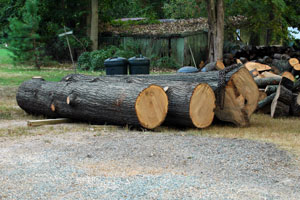A couple of weeks ago, in Woodworker’s Journal eZine Issue 310, Woodworker’s Journal editor in chief Rob Johnstone wrote in his introductory editorial about a friend who’d questioned him on the viability of cutting his own lumber for a project. Rob asked eZine readers if any of them had ever chopped a tree down, turned it into lumber and built a project. Many of them had — including Herb Brodie, who shares his story here.
I have many large, old oak trees on my lot. Every couple of years, one fails for a variety of reasons — from wind to rot. I’ve cut a 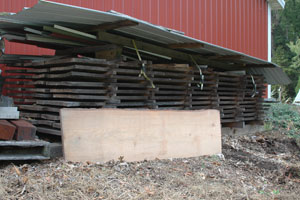 lot of firewood from these trees over the last 30 years. In 1999, while sawing, I thought that the wood was too good for a fire, so I saved about 15 feet of 26-inch diameter trunk. I then made a jig out of 2×6’s on the log and fixed an aluminum frame on my chainsaw that allowed me to cut slabs off the log. You can buy outfits like this now, but mine was entirely homemade. Each slab took me about an hour to cut and another hour to relocate the jig for the next cut. I kept the slabs at least 6/4 thick because the precision of my cutting wasn’t good enough to ensure uniform dimension. I trimmed the slabs to uniform width with a circular saw. I ended up with 12 boards ranging from 12 to 24 inches wide by 15 feet long. I stacked the boards horizontally with spacers for air drying in a well-ventilated shed, where they stayed for six years.
lot of firewood from these trees over the last 30 years. In 1999, while sawing, I thought that the wood was too good for a fire, so I saved about 15 feet of 26-inch diameter trunk. I then made a jig out of 2×6’s on the log and fixed an aluminum frame on my chainsaw that allowed me to cut slabs off the log. You can buy outfits like this now, but mine was entirely homemade. Each slab took me about an hour to cut and another hour to relocate the jig for the next cut. I kept the slabs at least 6/4 thick because the precision of my cutting wasn’t good enough to ensure uniform dimension. I trimmed the slabs to uniform width with a circular saw. I ended up with 12 boards ranging from 12 to 24 inches wide by 15 feet long. I stacked the boards horizontally with spacers for air drying in a well-ventilated shed, where they stayed for six years.
In 2005, I deemed the boards cured enough to start using them for projects. It was a good idea to saw them as 6/4 because there was a lot of warp and cup. I made a jig that allowed me to clamp a board and plane down one side using a router on a rail. I could then turn the board over and plane down the other side with the router. This made a ton of chips and wasted a lot of wood, but the result was a straight, useable piece of lumber up to 24 inches wide.
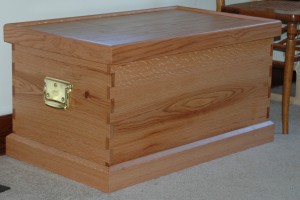 A toy chest was a six board box with trim. The top, sides and bottom of this box are each a single board. The sides are fitted with large dovetails. The top and bottom float in slots to allow for expansion and contraction of the wood. The overall dimensions of the box are about 24 inches wide by 36 inches long and 17 inches deep.
A toy chest was a six board box with trim. The top, sides and bottom of this box are each a single board. The sides are fitted with large dovetails. The top and bottom float in slots to allow for expansion and contraction of the wood. The overall dimensions of the box are about 24 inches wide by 36 inches long and 17 inches deep.
I also made a swinging cradle. The cradle can be mounted in the swing, or it can be removed to sit on the floor. This way, the baby can be moved from place to place in the cradle while the swing remains where most needed. The swing is entirely held together with removable pegs so that it can be torn down for storage. I built this cradle and swing in Maryland, then put all the pieces in a box and sent them to my daughter in Oregon. I included a video on how to put it together. My son-in-law glued the cradle together and applied an oil finish. It has served three grandchildren.
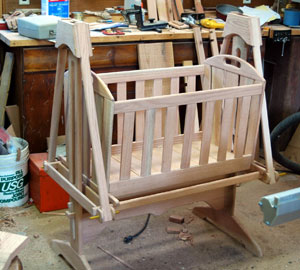 I made two other toy chests, several bookcases and children’s chairs. The lumber was gone by 2007. But, I lost another larger tree that year. I gained three 12-foot logs 30 to 38 inches in diameter. I did not have a chainsaw capable of sawing these logs into lumber. I hired a local farmer who had a portable band saw. He could cut with precision, so I had 5/4 slabs cut. Within two hours, I had 36 boards ranging from 15 to 30 inches wide and 12 feet long. I cut four cords of firewood from the rest of the tree that sold for more than I paid for the band saw work.
I made two other toy chests, several bookcases and children’s chairs. The lumber was gone by 2007. But, I lost another larger tree that year. I gained three 12-foot logs 30 to 38 inches in diameter. I did not have a chainsaw capable of sawing these logs into lumber. I hired a local farmer who had a portable band saw. He could cut with precision, so I had 5/4 slabs cut. Within two hours, I had 36 boards ranging from 15 to 30 inches wide and 12 feet long. I cut four cords of firewood from the rest of the tree that sold for more than I paid for the band saw work.
I trimmed and racked these boards outdoors with a metal roof fashioned 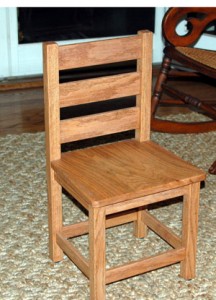 over the stack. These boards dried more quickly and more uniformly than did my 1999 stack. This spring, I pulled some out to make new baseboards and window trim inside my 100-plus-year-old house. They are straight with little cup and have even thickness. I worked with widths that fit my jointer and thickness planer. I again made a jig for my router for wide boards, and I was able to get a pretty good surface on a 28-inch-wide board. I’m letting that board sit for a while to see if it is stable enough to use whole.
over the stack. These boards dried more quickly and more uniformly than did my 1999 stack. This spring, I pulled some out to make new baseboards and window trim inside my 100-plus-year-old house. They are straight with little cup and have even thickness. I worked with widths that fit my jointer and thickness planer. I again made a jig for my router for wide boards, and I was able to get a pretty good surface on a 28-inch-wide board. I’m letting that board sit for a while to see if it is stable enough to use whole.
So, now I have a plentiful supply of wide oak boards from a tree in my yard. I have a lot of projects in mind. I love to work with oak. But, at 70 years old, I’m finding it harder than it used to be to pick up a 2 ft. by 12 ft. by 5/4 oak board and carry it into the shop.
